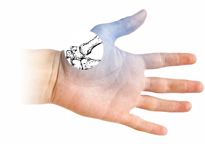What is Arthritis of the Thumb?
The joint between the base of the thumb and the wrist (the carpometacarpal joint) is subjected to a lot of stress. This saddle-shaped joint is designed to provide a wide range of movement for the thumb, allowing it to swivel, as well as pivot and pinch.
As with all joints, cartilage covers the ends of the bones, enabling a smooth, gliding movement. When that cartilage begins to wear out, due to osteoarthritis or just general “wear and tear,” the bones begin to rub against each other, causing pain and damage to the joint and the bones themselves.
Symptoms
In addition to suffering from pain and swelling, people with arthritis of the thumb may struggle with a decreased range of motion and difficulty grasping objects. Symptoms of basal joint arthritis include:
Pain at the base of the thumb
Difficulty with tasks such as opening jars or door knobs
Difficulty grasping keys or anything that requires a pinching or gripping motion
Over time, pain may occur even when not using the thumb to grasp or grip, such as stiffness in the morning and a general achiness in the evening. A protruding bump may occur at the base of the thumb, making it appear to be out of joint.
Early diagnosis and treatment will not only relieve discomfort, it may slow the degeneration of the joint.
Diagnosis and Treatment
Diagnosis begins with a thorough physical examination. This may include x-rays and other diagnostic tests. Treatment would depend on the severity of the condition and how long it has persisted. Fortunately, there are a wide range of treatment options available, both non-surgical and surgical, that can reduce pain and restore movement.
Although renowned for his surgical ability, Dr. Asif is a firm believer in using conservative, non-operative treatment plans before considering surgery. For arthritis of the thumb, these might include medication, splinting, hand therapy, ergonomic modifications, and lifestyle changes.



